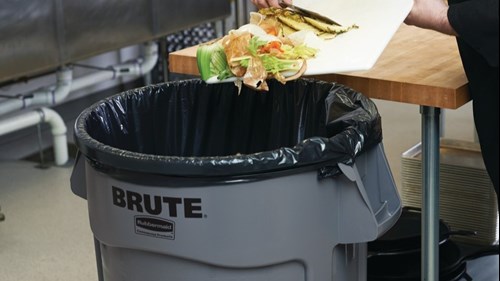How can separating food waste benefit your business?
Against the backdrop of increased competition, higher consumer expectations and heightened costs, your business’ environmental credentials are under close scrutiny.
Many facility users have come to expect easy access to paper, plastic and glass recycling bins as a given. But to get ahead of the competition, businesses must now carve out further ways to help the 88% of consumers who want brands to assist them in being more sustainable.1 Providing easy-to-access, visible food waste containers as part of an efficient recycling system can help businesses step up their recycling. The environmental repercussions of not recycling food waste are substantial: food waste alone generates 8-10% of global greenhouse gas emissions and roughly a third of food produced worldwide is lost or wasted.2
Being blind to the impact of sending food waste to landfill ultimately costs your business’ bottom line. It also presents reputational risks, with consumer decision-making increasingly influenced by perceptions of a business’ environmental credentials. Here, we outline how your business can take action on food waste and cut ahead of the competition.

The reality of food waste
In the EU, around 88 million tonnes of food waste are generated annually. That’s equivalent to 174kg of waste per person, 143 billion Euros and 170,000,000 tonnes of CO2.3 In the UK alone, around 40% of food waste is currently disposed of via landfill.4 Though more than half of food waste is recycled, the 40% that isn’t is disproportionately devastating for the planet. A deadly perpetrator of global warming, methane produced by the process of layering rotting food waste in landfill has a 28-34 times greater 100-year global warming potential than carbon dioxide.5
When recycled properly, food waste can be converted into fertilisers for agriculture or used as a renewable source of energy. Investing in food waste solutions ahead of the competition only solidifies confidence that your business takes sustainability seriously and sets you apart in a world of ‘greenwashing’.
It's time to become more systematic in industry’s approach to food waste.
Harness early demand for food waste containers
The UN’s Sustainable Development Goal 12.3 - which aims to reduce food waste across the supply chain and at consumer and retail levels - has assisted in waking people up to the importance of recycling food waste.6
However, food waste recycling containers are not yet commonplace in facilities in either front or back-of-house. Considering how your facility can recycle food waste better positions you as a business that takes sustainability seriously.
As regulators seek to combat the environmental impact of food waste and improve regional and national recycling rates through increased landfill tax, the cost of incomplete or inefficient recycling systems will only heighten. For hospitality settings and facilities such as canteens and food courts, the cost of mixing food waste with general waste could be massive.
How much could you save with better recycling?
Your business stands to save through proper separation of food waste into designated recycling containers, easily signposted for your facility users. Installing efficient systems such as RCP’s Slim Jim Recycling Stations to capture organic waste and compost can be easily implemented as part of your recycling system.
Getting the right recycling setup tailored to your facility can be confusing, which is why we offer a free consultation with our in-house commercial recycling experts who will help you identify how improved recycling can boost your output while also reducing costs.
You can also take our free 90-second recycling audit. Answer just six simple questions to get an indicative cost and waste saving by improving your recycling systems.
Food waste recycling doesn’t mean compromising on space
Commercial space comes at a premium, which is why Slim Jim Recycling Stations are designed to fit in the tightest spaces, ensuring organic waste and compost containers can be integrated seamlessly alongside your other recycling stations. Slim Jim Recycling Stations combine front-of-house aesthetics with back-of-house functionality, so they are perfect for both sides of your facility.
Whether you’re in an office space, hospitality setting, school or elsewhere, you can choose colourways in line with your country’s colour schemes and visible signage to direct facility users to the correct bin.
For an even sleeker aesthetic approach to front-of-house food waste recycling, consider the RCP Configure multi-stream recycling system, which is at home in high end environments. Read more about how you can Configure better looking recycling systems here.
Buy Better, Waste Less
We’re confident in the durability of our waste solutions. The Vented Slim Jim comes with a 10-year warranty and the Configure comes with a 5-year warranty, so you can be too. Buying better means your products last longer. And if your products last longer, you waste less too, which also supports your sustainability goals.
Initiatives such as WRAP’s Hospitality and Food Service Agreement have been a catalyst for change for many businesses, inspiring them to take action against food waste. However, at this early stage, investing in durable food waste solutions puts you ahead of many businesses who may be slower to react to evolving consumer expectations.
1 Forbes
2 United Nations Environment Programme (2021) Food Waste Index Report 2021 and FAO (2011) Global Food Losses and Food Waste. Extent, Causes and Prevention.
3 Eurostat (2020)
4 Vision 2020
5 UNECE Sustainable Development Goals
6 Food and Agriculture Organization of the United Nations
